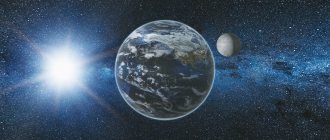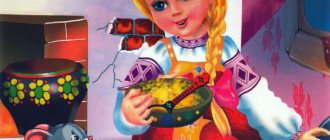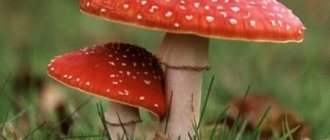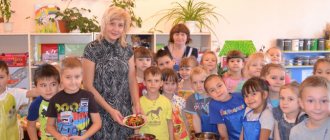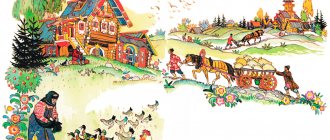We are earthlings. All countries, cities, forests and oceans known to us are located on one planet - Earth. It belongs to the solar system. The solar system is made up of eight planets revolving around one star, the Sun. In addition to Earth, the system includes Mercury, Venus, Mars, Jupiter, Saturn, Uranus and Neptune.
Earth is the third planet farthest from the Sun. And the only one of all the planets in our system on which there is life. Why?
Scientists believe that there are many conditions necessary for the emergence of life on the planet. This includes the temperature regime - not too hot and not too cold - and the presence of water, and the atmosphere in which there must be a number of certain elements, and much more. Not a single planet in the solar system, with the exception of Earth, meets all the requirements. Mercury is too hot, Uranus is very cold, Venus has no atmosphere at all. But our planet seems to have been created for life to arise on it.
Our article today will help you introduce your child to our amazing planet, tell you about the history of the Earth, its place in space, structure and other interesting facts.
Description of planet Earth for children
Earth is not the largest of the planets in the solar system. On the contrary, it is one of the smallest - only Mercury and Venus are smaller than it. But at the same time, the radius of the Earth is 6 thousand 371 kilometers.
The earth is almost perfectly round. At the poles it is slightly flattened. Therefore, two different radii of the Earth are often called: equatorial (in the middle of the planet) - 6378 km and polar (at the “ends”) - 6357 km.
In ancient times, people did not know that the Earth is spherical. They imagined something like a round flat plate. Only after the sailors circumnavigated the Earth and returned to the same place, it became clear that our planet is a ball. Now there is no doubt about it: we have seen many times photographs of the Earth taken from space. By the way, in many photographs the seas, mountains and even large cities are clearly visible.
Earth Rotation
The Earth, like other planets in the solar system, undergoes a complex rotation: around the Sun and around its axis (an imaginary line passing through the center of the planet). Moreover, around the Sun the Earth moves not in a circle, but in an ellipse - this is such an elongated circle.
It is thanks to this rotation that day and night come on Earth, and summer gives way to winter.
Everything is clear with the time of day: day is on that part of the planet that is currently facing the Sun, night is on the opposite. The Earth makes a complete rotation around its axis in approximately 24 hours - during this time a day passes on Earth.
The seasons are more complicated. The Earth makes a complete revolution around the Sun in 365 days. Many people think that the change of seasons is associated with the distance of the Earth from the Sun. But it is not so. The angle of the Earth's inclination relative to the Sun has a much stronger effect on air temperature. The fact is that the Earth's axis (around which rotation occurs) is tilted relative to the Sun by more than 23 degrees. And during rotation, the sun's rays fall on the Earth in different ways. If it’s straight, summer is coming, if it’s at an angle, it’s getting colder. The greater the slope, the colder it is.
The most direct rays fall to the equator, which is why the weather is almost always smooth there, and the extreme points of the Earth - the poles - are so inclined that the sun glides across the surface and does not warm the earth. That's why it's cold in the Arctic and Antarctic even in summer.
How did planet Earth appear?
The child will probably have a question about how our planet was formed. Scientists can only make assumptions on this matter; they do not have an exact answer.
The main hypothesis is that 4.6 billion years ago the Sun arose from a huge gas cloud, and under its influence, the planets of the solar system, including the Earth, were formed from the cosmic dust around. At that time, it bore little resemblance to the planet we live on. Most likely, it was a fireball, which, as it cooled, turned into a stone desert - without water, atmosphere and, of course, signs of life.
Gradually, under the influence of various processes occurring in the depths, various substances rose to the surface. Some turned into water, others participated in the formation of the atmosphere. This happened slowly: scientists believe that the formation of the oceans and surfaces took more than 200 million years.
What is planet Earth made of?
The child will be interested in learning about the structure of our planet. The earth, if you imagine it in cross-section, consists of several layers.
In the very center is the core, solid on the inside and liquid on the outside. Its composition is metal alloys, mainly iron and nickel. The core occupies most of the diameter of the earth, it is the size of the planet Mars. There is an inner and outer core. This part of the earth is very hot, and the deeper it is, the hotter it is. It is impossible to reach such a level, but, according to scientists, the temperature inside the core can be higher than in the Sun - up to 7 thousand degrees.
Above the core is the mantle. This is the most important layer of the Earth - and the largest (over 80% of the total volume). This is where most of the substances that make up the Earth are concentrated. These are mainly iron compounds, but the structure of the layer is not entirely solid: the mantle is rather viscous, so it is often said that the earth's crust “floats” on the mantle.
The earth's crust is the upper part of solid earth. Compared to other layers it is thin. There is continental and oceanic crust. The layer of continental crust reaches 40–50 kilometers, and under the oceans - 5–10. The crust makes up about 1% of the Earth's mass.
The earth's crust and upper mantle are called the lithosphere.
And the hydrosphere is the entire water part of the Earth’s surface, which includes the World Ocean, waters and glaciers, and groundwater.
It turns out that for a surface covered with water, the hydrosphere is located above the lithosphere.
Even higher is the atmosphere. This is no longer part of the planet, but its gas shell, which is located above the Earth and rotates with it.
The composition of the earth's atmosphere, and more specifically the oxygen content in it, played a key role in the emergence of life on Earth.
In addition to oxygen, nitrogen and other gases are present in the Earth's atmosphere. And thanks to the ozone layer in the atmosphere, the Earth is protected from most of the sun's ultraviolet radiation.
Earth's Moon - explanation for children
Children should not forget that the Earth has a faithful satellite - the Moon. It reaches a width of 3474 km (about a quarter of the Earth's diameter). Our planet has only one satellite, although Venus and Mercury do not have them at all, and some have two or more.
The moon was formed after a giant object crashed into the Earth. The torn off debris became the constituent material of the Moon. Scientists believe the object was roughly the size of Mars.
| Moon |
How life originated and developed on the planet
For millions of years, planet Earth remained uninhabited. Scientists have found confirmation that living organisms appeared on Earth about 3-4 billion years ago, during the Precambrian period of the Earth's development. Of course, these are not the animals we are used to, but protozoa - microorganisms.
More developed animals and plants appeared later - during a time called the Phanerozoic. This period is divided into 3 eras: Paleozoic, Mesozoic and Cenozoic. During the Paleozoic, invertebrates, insects and fish appeared; The Mesozoic gave us dinosaurs, and the Cenozoic gave us mammals. This happened more than 65 million years ago, and it is still believed that mammals are the highest stage of development for living organisms. Man is a mammal.
You might be interested in:
Inexplicable, but true: many children adore dinosaurs. If your child also enthusiastically watches cartoons and flips through pictures with these amazing giant creatures, we offer you our article with interesting facts about dinosaurs for children.
Highest point
Interesting fact about the highest point.
Mount Everest is not technically the highest point on Earth. Since the Earth is not perfectly round, objects located near the equator are slightly "higher" or closer to space than objects located further from the equator. Thus, Mount Chimborazo in Ecuador is 2,743 meters lower than Everest, measured from sea level. However, due to the "bulge" of the equator, its summit is actually about 2,400 meters further from the center of the Earth than the summit of Everest.
Continents and oceans
71% of the Earth's territory is covered with water. The land exists in the form of six continents: Eurasia; Africa; North and South America, Antarctica and Australia. The largest continent is Eurasia, the smallest is Australia.
There are four oceans on Earth. They are connected to each other (this is the so-called World Ocean), but at the same time they differ greatly - in temperature, bottom features, salinity. The Pacific Ocean is the largest and deepest, the second largest is the Atlantic, the third is the Indian (compared to the Atlantic, it is smaller but deeper). And the smallest is the Arctic Ocean. It is also the coldest because it is located near the North Pole and is partially covered with ice.
On our planet there are four climatic zones - these are territories that seem to encircle the planet. In one zone all over the Earth there are approximately the same conditions for life: temperatures, humidity, precipitation.
The equatorial belt runs through the very center of the Earth. Here the weather hardly changes throughout the year - summer, it rains and about +25 degrees.
There are two tropical zones, they are located on both sides of the equatorial one. It is dry and warm here, but the difference between summer and winter is already obvious: in winter it can be about +15 degrees, but in summer - up to +50.
We are familiar with the climate with cold winters and warm summers. It is typical for temperate zones. There are also two of them, and they are located after the tropical ones in the direction from the equator.
Arctic zones are located at the Earth's poles. It is the coldest here, especially in winter. But even in summer the temperature rarely rises above zero.
Of course, this division is conditional. The climate does not change dramatically when moving from one climate zone to another. There are transition poles: two subequatorial, two subtropical and two subpolar, where the characteristics of neighboring poles appear. If you move smoothly from one belt to another, changes in the weather are practically unnoticeable. But if you fly by plane, you can feel the difference.
The weather in different parts of the Earth depends not only on the distance from the equator, but also on the topography. The main types of relief on Earth are mountains and plains.
In terms of area, plains occupy most of the land. We can see this on a map or globe. Neither of them, plains and mountains, depending on their height, are indicated in green, yellow or brown. The highest mountains are dark brown (Himalayas, Andes, Caucasus).
The highest point of land in the world is Mount Chomolungma in the Himalayas - 8848 meters above sea level. And the lowest is in the ocean, this is the Mariana Trench (11,022 meters below sea level).
Structure of the Earth
Based on various studies, scientists have divided the Earth into three parts - core, mantle and crust.
The core is the heaviest part of our planet, its radius is about 3500 km, and its temperature is 4000 degrees and above. It is supposedly divided into an outer liquid part, consisting of sulfur and iron, and a solid inner part, containing an alloy of iron and nickel.
The mantle is not yet available for full research, so all data was obtained using geophysical and geochemical methods. It is in a solid state, from 30 to 3000 km from the surface and consists of ultrabasic rocks, refractory elements.
On top of the mantle lies the earth's crust, consisting mostly of rocks and minerals. It is on it that the oceanic and continental crust is located. Its thickness ranges from 5 to 10 km under water and up to 80 km on land.
Scientists have hypothesized that the oceanic crust was initially formed, and as a result of various processes that occurred inside the planet, folds were formed - sections of mountains. Over time, the thickness of the crust increased, forming the continental crust.
BOOK FOR CHILDREN “Tales of Mother Earth” page 1 of 2
(for preschool and primary school age)
The book shows the beauty of our native land, fosters a love of nature and a sense of responsibility for the world around us. The book contains 250 fairy tales and poems that will bring children’s consciousness closer to nature and teach them to care for it; lyrical poems that deeply reveal the wonder of nature to children; creative tasks and games that develop in children a sense of the relationship between nature and man. In the book you will find legends and fairy tales on the topics:
|
THE PURE VOICE OF WATER (excerpts from the book)
::: Who needs some water :::
A girl was running in the yard and accidentally stepped on a puddle. She shouted angrily:
“You, the water, wet my shoes.” Go away!
The large puddle instantly evaporated.
- Meow, girl. Have you seen a puddle here? “I’m thirsty,” the kitten asked the girl.
The girl didn’t answer him and went to the other end of the yard. Flowers grew there. Their heads drooped and plaintively asked: “Drink, drink!”
The girl also felt hot, and she ran home. In the room, she saw with horror that there was little water in the aquarium. Her favorite fish were floundering among the algae.
“Mom,” the girl screamed. — I urgently need water for the fish.
- What a problem! There is no water in the taps. You can't wash your face. “You can’t cook dinner,” Mom answered.
- Mom, can some water disappear if someone offends it? — the girl asked quietly.
“Maybe, but she will definitely return if she asks for forgiveness,” my mother answered seriously.
The girl closed her eyes and whispered: “Vodichka, excuse me and come back soon. Everyone feels bad without you.”
- Daughter, water is running out of the tap again! - Mom was happy.
The girl poured fresh water for the fish and looked out the window. In the yard, a kitten was drinking from a puddle.
Questions and tasks:
- Turn on the music. All children are trickles of water. If the music is quiet, the streams swirl smoothly and slowly. If the music is loud, the streams spin quickly, colliding and rolling away from each other.
- What does water look like when it's smiling or angry?
- Draw a portrait of water.
::: Glory to the water :::
Glory, honor, always and everywhere to our magical and good water! In rivers, seas, oceans, ponds All day long in great labors
Droplets, streams, streams of it are accomplishing their great work! Something terrible will happen to us if it stops even for a moment.
Questions and tasks:
- What happens if the water disappears forever?
- One of the children is the Water Fairy. He splashes water from a cup on the children. Those who are hit by drops of water should say something good about the water.
::: Crystal water :::
The water flows without stopping, rings with crystal purity, will not stop for a second and will not part with you.
It is around you, everywhere: In the pipe, in the river, and even in tea, Baby, water is like a miracle, Everyone knows about this miracle.
But the water is offended, When it is not taken care of and poured in vain, - It is afraid to disappear forever!
Questions and tasks:
- Why should we save water?
- Draw different places where water lives.
::: Good Sea :::
One day a small raindrop fell into the sea and was surprised:
- Why are you so huge, you can’t even see the shore?
“Because I have a mighty power,” answered the sea.
“I’m not as strong as you,” said the droplet, “but I can give water to grass or a flower.”
- And I am very strong. I am the strongest. Look how strong I am,” the sea roared.
It raised huge waves and began to throw ships in different directions.
- Stop! - the droplet screamed. - Why break ships? Isn't it possible to be strong and kind?
The sea responded:
- Can. This is me just showing my strength. Actually, I am a good sea, strong and kind!
The sea actually became kind, blue and calm. The ships sailed calmly to different shores, the children swam in the warm water, and the sea gave the fishermen a lot of fish.
“I am good,” the sea whispered tenderly. - I am very strong and kind.
Questions and tasks:
- What is the character of the sea?
- What makes the sea happy and what makes it sad?
- Why do you think the water in the sea is salty?
- Turn on some music and ask the children to imagine themselves as waves on the sea. Ask them to depict the dance of waves, seagulls, and dolphins to the music.
- Imagine that the sea has invited you to your birthday. Draw a pattern of seashells, pebbles and algae as a gift to the sea.
::: Seabed :::
The bottom of the sea is like a fairy tale, There are so many miracles in it! But we can’t get into the underwater forest without a mask.
Nimble, colorful fish of the country-city, but without a mask the bright colors are invisible.
Unnoticeable crab holes, traces of seahorses and algae patterns without sea glasses!
Questions and tasks:
- Do you like to dive?
- What does the seabed remind you of?
- Imagine that one day you found a magic pearl on the seabed that could make wishes come true. What wishes would you ask her to fulfill?
- What materials do you think sea creatures use to build their houses? Draw a house for a crab, seahorse or sea urchin.
- Imagine that one day, while swimming underwater, you met an unprecedented sea animal and became friends with it. Draw a portrait of your new friend.
- Tell us what flowers and plants grow in underwater forests and gardens. Draw these plants.
- Imagine that one day the king of the sea invited you to a sea ball. Tell me what you did at this ball.
::: We are at sea :::
In fins, in a mask, with a sea snorkel, I decided to conquer the depths, My younger brother went with me, Together with him we are like giants.
We will cross the expanses of the seas, The depths have been waiting for us for a long time, Let them call us eccentrics, This is all empty talk.
We will meet unprecedented animals, Maybe we will find an underwater treasure, And we will go to the king of all rivers and all seas for a dinner party.
We'll play tag with the fish, a seahorse will give us a ride, we'll go visit a fairy-tale mermaid, we don't want to go home at all.
Let's rest in beds made of shells, We can't find better beds, It's more comfortable than folding beds! It's a pity that it's time for us to go back.
